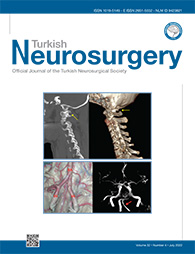MATERIAL and METHODS: This study included 98 patients, 50 patients were in trans-SAP PETLD group and 48 patients were in conventional PETLD group. Visual analogue scale (VAS), Oswestry disability index (ODI), gender, age, blood loss, operation time, the frequency of X-ray fluoroscopy and the percentage of highly migrated herniation were evaluated and compared between the trans-SAP PETLD and conventional PETLD group.
RESULTS: In both trans-SAP PETLD and conventional PETLD group, VAS and ODI were decreased at postoperative 1 day and 3 months compared with preoperative (p<0.001). What's more, the VAS and ODI of postoperative 3 months were lower than postoperative 1 day (p<0.001). There was no difference in gender, age, blood loss after the operation, and VAS during operation between trans-SAP group and conventional group (p>0.05). The blood loss during the operation of trans-SAP group was higher (p<0.05), but the operation time and frequency of X-ray fluoroscopy were lower than conventional group (p<0.001). Last, trans-SAP group had a higher percentage of highly migrated herniation (p<0.001).
CONCLUSION: Both the conventional way and trans-SAP approach can achieve excellent surgical results. But, in trans-SAP group, the operation time is shorter, and X-ray fluoroscopy is less. PETLD with visual trephine has more advantages in highly migrated herniation and maybe easier to be mastered by young surgeons.
Keywords : Percutaneous endoscopic transforaminal lumbar discectomy, Trans-superior articular process, Visual trephine, Migrated lumbar disc herniation




